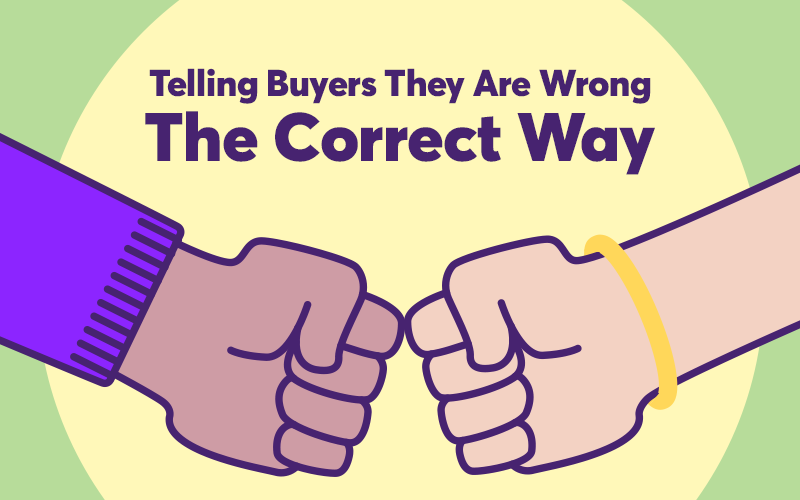Buyers are the most intricate beings to deal with. You might assume if you challenge your prospects, they’ll hang up and never speak to you again. But if you do it right, you’ll get the opposite reaction: Potential buyers become more engaged, invested, and ultimately, eager to buy.
Successfully changing the buyer’s mindset earns you authority and credibility. You also prove you’re committed to the buyer’s success, as you are clearly willing to risk short-term goodwill to help them.
Follow these five guidelines to challenge your prospects without sounding hostile.
Pick Your Battles
It’s not worth challenging your buyer and prospect on every issue. If you frequently correct or contradict them, they’ll stop listening.

If, on the other hand, you challenge them infrequently, the buyer will think, “Hmm, this is probably important — I should take this seriously.”
Use this three-part decision framework as your guide:
- Is questioning or disagreeing with them ultimately in their best interests, either because they’re operating under false assumptions or missing crucial information?
- Do I have proof to back up my statements?
- Is this pertinent to the deal?
Don’t challenge your prospect unless you answer “yes” to all three questions.
Build Rapport First
Gaining the respect of your buyer makes them more receptive to being challenged. If you tell the buyer she’s wrong two seconds into your first call, she’ll be taken aback, if not outright annoyed. But if you first earn her trust and put her at ease, she’ll listen with an open mind.
Build rapport both virtually and over the phone or in person. Interact with buyers on social media before you reach out and include references to commonalities or mutual contacts in your emails.
Once you’re talking to a prospect, strengthen your connection by discussing shared interests, asking questions about their professional projects, and sharing details about your own life when appropriate.
Preface Your Challenging Statement
To sound less combative, leading to your challenge. Doing so gives prospects warning you’re about to contradict them and shows respect for their beliefs (even if you think those beliefs are wrong).
Here’s an example ⬇
Before: “Actually, the system you’re currently using will be out-of-date in 10 months.”
After: “I’d like to offer a different opinion. According to my firm’s projections, the system you’re currently using will be out-of-date in 10 months.”
Other potential qualifying statements include:
- “I’d like to politely disagree … ”
- “I see where you’re coming from, and … ”
- “It may surprise you to learn … ”
- “I have a different perspective … ”
- “I used to [think/feel/believe] that as well until I learned X … ”
- “I have some interesting data that suggests otherwise … ”
Ask for Permission
Are you nervous your prospect will react negatively if you dive straight into challenging them? Ask for permission first. Giving you the go-ahead reestablishes some of their authority, which makes them less sensitive to hearing they’re wrong.
Ask, “Are you open to hearing a different perspective?” or “Can I share a differing opinion with you?”
When you want to be bolder, say, “I think I can change your mind. Will you let me try?”
Databox CEO and former HubSpot VP of Sales Pete Caputa recommends following this sample dialogue:
Rep: “There’s something I think you should know in order to make the best decision possible. But I’m worried you won’t like hearing it.”
Prospect: “What is it?”
Rep: “Will you keep an open mind?”
Prospect: “Yes.”
Rep: “[Challenging statement.]”
End With “WIIFM”
“WIIFM” stands for “What’s In It For Me.” After you’ve challenged the buyer, explain why knowing this information benefits them.
For example, if you’ve just told them they won’t hit their year-end objective with their current strategy, follow up with, “Fortunately, if you make adjustments by the end of this month, you’ll be able to make your goal — with room to spare.”
Or perhaps you’re disagreeing with the buyer’s opinion of your product. You could say, “You’re not the only person I’ve talked to who has called our interface hard to navigate. Good news: We surveyed 5,000 random end-users in January, and 96% said the product was ‘easy’ or ‘extremely easy’ to use. Your IT team will be able to get up and running in four days or less.”
Stick to these guardrails, and correcting prospects will be far less risky. In fact, it will likely help you win their business.








 BONUS:
BONUS: The Challenge: Join this free course and I guarantee that after 5 days you will have the necessary skills to start generating B2B clients Growth Hacking and Prospecting techniques.
The Challenge: Join this free course and I guarantee that after 5 days you will have the necessary skills to start generating B2B clients Growth Hacking and Prospecting techniques.